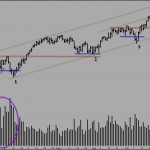Springs are my bread & Butter trade. No doubt about that.
They were first described by Bob Evans, a great teacher of the Wyckoff Method. Wyckoff had talked about something similar in a terminal shake out at the end of a prolonged trading range. It was Evans who saw other applications of the flush, which he described as a Spring.
For the swing traders (also day traders who can see the intraday in the daily chart) springs are an excellent trade setup to the long side. It is a great way to enter a long position in an uptrending market.
Swing Trading the Russell 2000
 Here is the Russell 2000 daily chart. This is a market that can trend nicely. Every pullback over the last 5-6 months has ended in a Spring.
Here is the Russell 2000 daily chart. This is a market that can trend nicely. Every pullback over the last 5-6 months has ended in a Spring.
Not all Springs work out. B and C both are valid Springs that would have gotten stopped out as the market shook out at 1. But at 1, we also have a Spring. Note, too, the heavy volume in this area. When we are in a trading range and the volume is high but we don’t fall lower, it means some larger players are in there buying. We want to ride their coattails and the Spring is an excellent way to do that because it tells us that there is low odds for any further downside.
We see additional Springs at 2, 3, and 4. Spring setups at 2 and 4 set up on top of market structure and Spring 3 occurs at the Demand Line where we expect buying to come in. All Springs also show price action at the time it is occurring that cue us that the downside is limited. These are all things we can anticipate in advance and watch carefully to see if what we expect is actually happening.
This is what is taught in our various educational tutorials which are being offered with a 30% discount through midnight tonight (Eastern or New York Time). If you are interested in learning more about Springs, market structure, how to read the importance of volume and a whole host of other market tells, the Black Friday sale that Helen has put up is a good opportunity for you at a discounted price. You can learn more here:

Leave a Reply